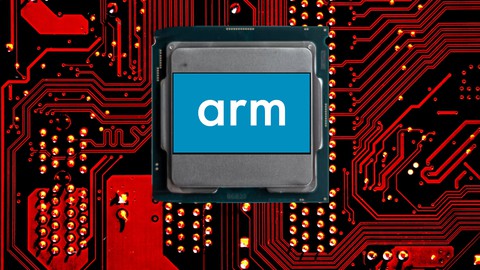
Introduction to Assembly Programming with ARM
Introduction to Assembly Programming with ARM, available at Free, has an average rating of 4.65, with 14 lectures, based on 83 reviews, and has 5722 subscribers.
You will learn about Understand the basics of ARM emulation and program structure The fundamentals of register, stack, and memory addressing modes The concepts of arithmetic and logical operators The main concept of branches, loops, and subroutine branches The ways to interact with simple hardware devices This course is ideal for individuals who are Programmers looking to understand the fundamentals of assembly or Programmers looking to learn ARM assembly It is particularly useful for Programmers looking to understand the fundamentals of assembly or Programmers looking to learn ARM assembly.
Enroll now: Introduction to Assembly Programming with ARM
Summary
Title: Introduction to Assembly Programming with ARM
Price: Free
Average Rating: 4.65
Number of Lectures: 14
Number of Published Lectures: 14
Number of Curriculum Items: 14
Number of Published Curriculum Objects: 14
Original Price: Free
Quality Status: approved
Status: Live
What You Will Learn
- Understand the basics of ARM emulation and program structure
- The fundamentals of register, stack, and memory addressing modes
- The concepts of arithmetic and logical operators
- The main concept of branches, loops, and subroutine branches
- The ways to interact with simple hardware devices
Who Should Attend
- Programmers looking to understand the fundamentals of assembly
- Programmers looking to learn ARM assembly
Target Audiences
- Programmers looking to understand the fundamentals of assembly
- Programmers looking to learn ARM assembly
ARM is becoming an increasingly popular language in the world of computer programming. It is estimated that over 200 billion devices contain an ARM chip, making the ARM language valuable to understand. By understanding an assembly language, programmers can have a better understanding of how code is compiled and run, making it possible to create more efficient programs. In addition to this, programmers can work at a lower level, allowing them to write code that interacts with hardware in an efficient manner.
In this course, you will learn:
-
How to emulate an ARM processor
-
How to interact with ARM processors through register and stack memory
-
How to interact with various memory types
-
How to conduct basic arithmetic and logical instructions
-
How to create branching logic
-
How to create basic loop structures
-
How to write functions and subroutines
-
How to interact with basic hardware
By the end of this course, you will have a fundamental understanding of the ARM processor, as well as assembly programming in general. You will be able to write basic ARM assembly programs, using various instructions available in the processor. You will also have the understanding required to further expand your knowledge, allowing you to become an expert in the area of assembly programming. You should consider this course if you are interested in learning about assembly programming, or ARM assembly!
Course Curriculum
Chapter 1: Introduction
Lecture 1: Emulation and Memory Layout
Lecture 2: Your First Program
Lecture 3: Addressing Modes
Chapter 2: Arithmetic and Logical Operations
Lecture 1: Arithmetic and CPSR Flags
Lecture 2: Logical Operations
Lecture 3: Logical Shifts and Rotations 1
Lecture 4: Logical Shifts and Rotations 2
Chapter 3: Conditionals, Loops, and Functions
Lecture 1: Conditions and Branches
Lecture 2: Loops with Branches
Lecture 3: Conditional Instruction Execution
Lecture 4: Branch with link register and returns
Lecture 5: Preseving and Retrieving Stack Data in Functions
Lecture 6: Hardware Interactions
Lecture 7: Learn More For Free!
Instructors
-
Scott Cosentino
Software Developer
Rating Distribution
- 1 stars: 1 votes
- 2 stars: 1 votes
- 3 stars: 8 votes
- 4 stars: 24 votes
- 5 stars: 49 votes
Frequently Asked Questions
How long do I have access to the course materials?
You can view and review the lecture materials indefinitely, like an on-demand channel.
Can I take my courses with me wherever I go?
Definitely! If you have an internet connection, courses on Udemy are available on any device at any time. If you don’t have an internet connection, some instructors also let their students download course lectures. That’s up to the instructor though, so make sure you get on their good side!
You may also like
- Best Parenting Skills Courses to Learn in March 2025
- Best Home Improvement Courses to Learn in March 2025
- Best Gardening Courses to Learn in March 2025
- Best Sewing And Knitting Courses to Learn in March 2025
- Best Interior Design Courses to Learn in March 2025
- Best Writing Courses Courses to Learn in March 2025
- Best Storytelling Courses to Learn in March 2025
- Best Creativity Workshops Courses to Learn in March 2025
- Best Resilience Training Courses to Learn in March 2025
- Best Emotional Intelligence Courses to Learn in March 2025
- Best Time Management Courses to Learn in March 2025
- Best Remote Work Strategies Courses to Learn in March 2025
- Best Freelancing Courses to Learn in March 2025
- Best E-commerce Strategies Courses to Learn in March 2025
- Best Personal Branding Courses to Learn in March 2025
- Best Stock Market Trading Courses to Learn in March 2025
- Best Real Estate Investing Courses to Learn in March 2025
- Best Financial Technology Courses to Learn in March 2025
- Best Agile Methodologies Courses to Learn in March 2025
- Best Project Management Courses to Learn in March 2025






















